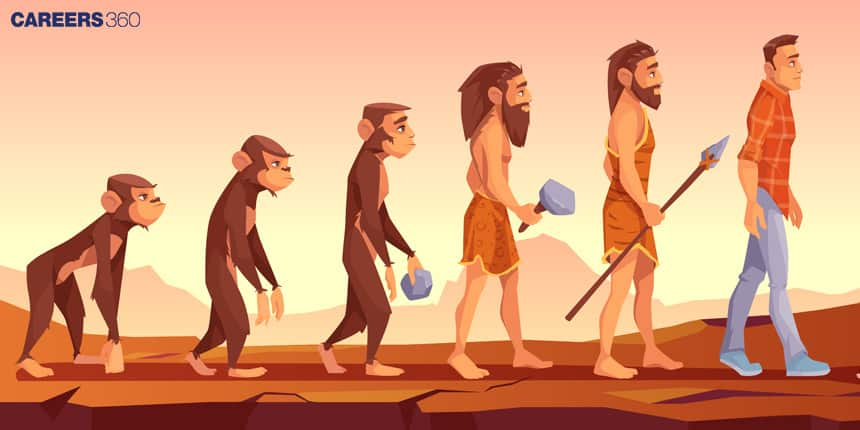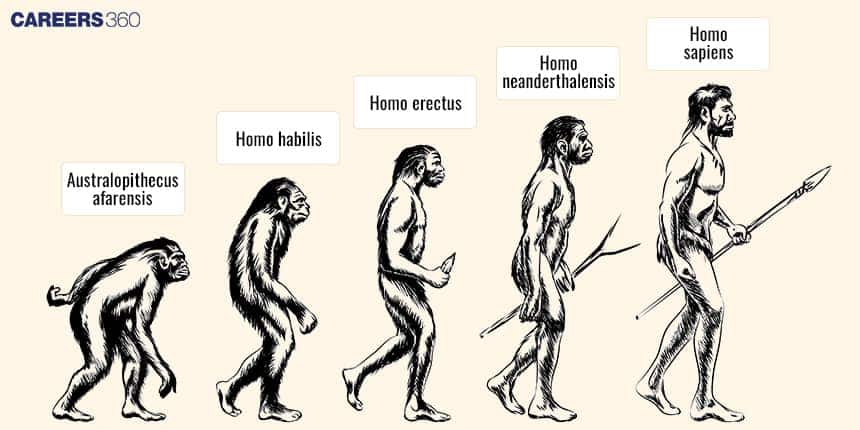Evolution by Stages: Definition and Examples
The 7 stages of human evolution trace evolution from early ancestors to modern man. These stages of human evolution show key developments such as bipedalism, tool use, and cultural growth. From Dryopithecus to Homo sapiens sapiens, the human evolution chart shows maps of the evolution of man and its origins and evolution. This is one of the important topics of evolution in Biology.
NEET 2025: Mock Test Series | Syllabus | High Scoring Topics | PYQs
NEET Important PYQ's Subject wise: Physics | Chemistry | Biology
New: Meet Careers360 B.Tech/NEET Experts in your City | Book your Seat now
- Definition of Evolution
- Stages in Human Evolution
- Stages of Human Evolution
- Implications for Conservation

Definition of Evolution
Human evolution is a gradual series of changes and adaptations that could evolve the primitive being into a modern man Homo sapiens. The life journey of human ancestors stretches over millions of years, tracing out the whole procedure of human evolution.
From the study of man's origin and evolution, one can get to know about the biological past and the elements of the environment in which he has survived. The evolution of man's stages, from the earliest ancestors to modern man, indicates a complex and very interesting process of growth in diversity and capability.
Also Read
Stages in Human Evolution
Some key stages make up human evolution- Dryopithecus, Ramapithecus, Australopithecus, Homo erectus, Homo sapiens neanderthalensis, and Homo sapiens sapiens. These periods trace the development of man and highlight the key steps that mark the origin and the process of human evolution.
For example, Dryopithecus marks the early divergence in the evolution of humans and apes, and Australopithecus marks a step forward in bipedalism, an important aspect of human development.

Stages of Human Evolution
The 7 stages of human evolution show the evolution of mankind. The major ones are discussed below:
Dryopithecus
Dryopithecus was an assumed common ancestor of human species and apes. The said genus survived for 15-10 million years ago in densely forested areas. Its diet was mainly herbivorous, and it lived a cave-man-like life in trees. These characteristics point to its primitive existence in the evolution of man.
Ramapithecus
Ramapithecus, found in the Shivalik Range of India, displayed characteristics such as thickened enamel on its teeth and a small canine tooth, pointing toward early adaptations toward human-like features. It is regarded as one of the very early links in the stages of the evolution of man.
Australopithecus
Australopithecus appeared about 4 million years ago. They were among the first ones to use bipedalism, an important milestone in human evolutionary history. The discovery of their use of stone tools added an important era in human evolution theory.
Homo Erectus
Homo erectus 2 million-100,000 years ago made some significant advancements in tools and societal organization. Java and China have fossils which depict communal living, and the ability to hunt and gather growing intelligence in homo sapiens evolution.
Homo Sapiens Neanderthalensis
The Neanderthals were robustly built, had a large cranial capacity, and hunted big animals. Since they lived in cold climates, they fashioned tools, dressed in animal skins, and interred their dead, reflecting a certain level of cultural sophistication within the steps of human evolution.
Homo Sapiens Sapiens
Early human beings showed unmatched intelligence in inventing fine instruments, such as artistic expressions and cultural behaviours, such as rituals. They spread out across continents, adapting to diverse habitats to create complex societies.
Implications for Conservation
Research into the adaptations of different hominid species to their environments seeks to learn many of the dynamics involved in evolution and the factors motivating natural selection. The knowledge is also important for developing modern conservation efforts through the general education of the public on the importance of biodiversity and the impact of environmental alteration on species' survival.
Also Read
Frequently Asked Questions (FAQs)
Dryopithecus is considered to be the common ancestor of both man and apes. It was fastened to densely forested areas and had characteristics that give insights into the early phases of hominid evolution.
Australopithecus was a breakthrough stage of human evolution given its upright posture and stone tool use; very early human adaptations to terrestriality and tool use.
Homo erectus had advanced tool use, evidence of communal living, and controlled use of fire, evidencing considerable developments of the mind and social life of early humans.
Neanderthals were larger in cranial capacity and physically more robust compared to Homo sapiens. They were much involved with hunting large mammals and had rather different cultural practices from those of modern humans.
Research into the evolution of our species can provide answers regarding our biological origins, giving proof for medical studies of hereditary diseases and helping to understand human behaviour, social structures, and cultural developments.
Also Read
03 Dec'24 10:56 AM
30 Nov'24 08:28 PM
27 Nov'24 08:01 PM
26 Nov'24 11:40 PM
23 Nov'24 01:48 PM
21 Nov'24 05:41 PM
19 Nov'24 02:01 PM
19 Nov'24 11:02 AM
19 Nov'24 08:45 AM
18 Nov'24 10:54 PM